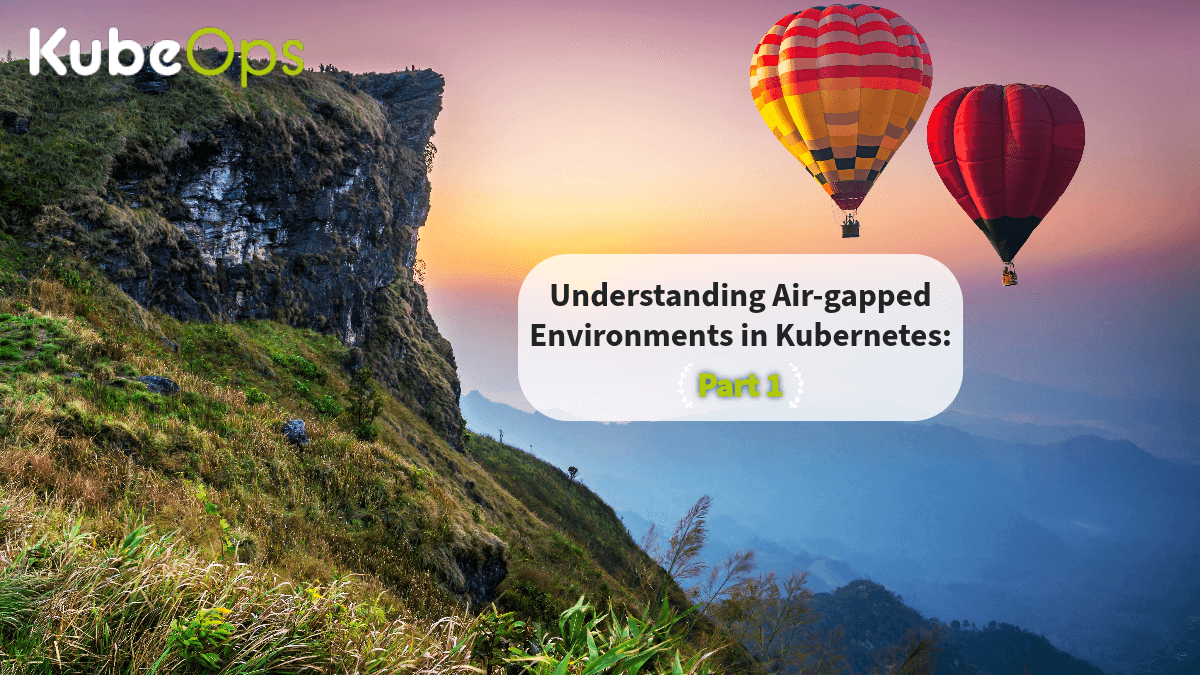Blogs
Understanding Air-gapped Environments in Kubernetes: Part 1

In the modern era of computing, data security and system integrity are paramount. This has given rise to air-gapped environments, particularly in Kubernetes. But what is an air-gapped environment? Why should businesses consider implementing it, and what are the prevalent strategies adopted? In this blog, we'll take you through the fundamentals of air-gapped environments, diving into Kubernetes tools that facilitate air-gap, including the innovative solution, KubeOps KOSI.
What is Air-gapping?
In its essence, an air-gapped environment refers to a network or system isolated from other networks, particularly the public internet. The name “air-gapped” metaphorically suggests that there's air separating the system from potential threats, ensuring that no unauthorized digital communication can occur. This ensures data remains secure from external threats and prevents unauthorized data exfiltration. For businesses dealing with sensitive data or critical applications, an air-gapped environment can be a vital shield against cyberattacks.
Kubernetes and Air-gapping: Common Strategies
Kubernetes, as a leading container orchestration tool, has evolved to accommodate the needs of diverse setups, including air-gapped environments. These are the common strategies adopted:
Dependency Management: Ensure all dependencies are internally accessible, meaning having a local registry or database to avoid fetching from the internet.
Regular Patch Management: Schedule frequent internal updates rather than relying on external patch management.
Continuous Monitoring: Keep a vigilant eye on system health and performance to detect anomalies swiftly.
Immutable Infrastructure: Embrace the concept of immutability where infrastructure components are replaced rather than changed. This can reduce potential inconsistencies and security vulnerabilities.
Backup and Recovery: Always have a local backup solution in place. Since fetching from external sources is restricted, it's vital to have a robust recovery system for both data and applications.
Internal Documentation: Maintain comprehensive internal documentation. Without access to external resources, teams should have all necessary information available in-house to manage and troubleshoot the system.
Authentication and Authorization: Implement strong authentication mechanisms, possibly integrating with existing enterprise solutions. Define clear role-based access controls to ensure that only authorized personnel can interact with the cluster.
Network Segmentation: Within the air-gapped environment, further divide the network into segments. This ensures that even if one segment is compromised, it doesn't lead to a system-wide breach.
Security Audits: Regularly conduct security audits, and given the nature of air-gapped systems, ensure these are thorough and often more stringent than those for connected systems.
End-to-end Encryption: Even within an isolated environment, data in transit should be encrypted. Ensure that data at rest is encrypted as well.
Application Vetting: Before introducing any new application or tool within the environment, it should undergo a rigorous vetting process to ensure it doesn't introduce vulnerabilities.
Training and Awareness: Ensure that all team members are aware of the unique challenges and protocols of operating within an air-gapped environment. Regularly train them on best practices and security measures.
With these strategies, Kubernetes can deploy, scale, and manage applications seamlessly in an isolated environment.
Tools for Kubernetes in Air-gapped Environments
Several challenges arise when air-gapping a Kubernetes environment:
- How do you manage container images and dependencies without external access?
- How do you ensure that the internal application and infrastructure updates are as frequent and timely as those in connected environments?
- How do you monitor system health and detect anomalies when you can't rely on external monitoring tools?
To solve this and many more problems, we need a set of tools. Let's take a look!
Harbor: An open-source cloud-native registry, Harbor offers features like vulnerability scanning and image signing, making it ideal for air-gapped deployments. Using Harbor, businesses can securely store and manage container images within their isolated Kubernetes clusters.
Private Git Solutions: Host and manage code repositories privately using solutions like Gitea or GitLab to ensure continuous integration and deployment (CI/CD) pipelines remain active and secure.
Artifact Repositories: Repositories like JFrog's Artifactory or Sonatype's Nexus Repository can be a challenge to access in restricted environments. However, self-hosted solutions ensure seamless management and retrieval of software artifacts within the air-gapped confines.
Rook-Ceph for Storage: Rook, combined with Ceph, provides a resilient storage system that’s perfect for air-gapped environments, offering block, object, and file storage in a unified system.
Multus for Networking Needs: Enhance Kubernetes networking with Multus by allowing the creation of multiple network interfaces per pod, vital in specific air-gapped network configurations.
OpenPolicy Agent (OPA) for Policy Control: OPA can be a godsend in air-gapped Kubernetes deployments. It enables fine-grained policy control to ensure that every action performed meets the strict criteria set for security and compliance.
Trivy for Vulnerability Management: With an air-gapped environment, security is paramount. Trivy is a comprehensive vulnerability scanner for containers, ensuring that the applications and dependencies you deploy are free from known security issues.
Monitoring in Air-gapped Environments
Ensuring optimal operation in an air-gapped environment doesn't stop at deployment. Continuous monitoring is critical. Using tools like Grafana and Prometheus, businesses can monitor their applications and systems effectively. Both tools can be seamlessly integrated into an air-gapped Kubernetes setup, providing real-time metrics and visualization to stay ahead of any potential issues.
Introducing KubeOps KOSI
KOSI is a specialized software installer for Kubernetes clusters. Drawing inspiration from Helm's usability, KOSI provides a streamlined, secure, and flawless method to define, install, and manage packages in Kubernetes. The ability to bundle images and other artifacts in a single package is especially invaluable in air-gapped deployments.
In the next section, we'll go into more detail about how KOSI is a perfect match for airgapped Kubernetes clusters.
Wrapping Up
The concept of air-gapped systems offers organizations a robust shield against many cyber threats. Yet, as we introduce complex orchestration tools like Kubernetes into these environments, challenges arise. With the right tools—ranging from image registries like Harbor to game-changers like KOSI—these challenges become surmountable, leading the way to secure, efficient, and innovative deployments.
In our upcoming post (Part 2), we will delve deeper into the challenges faced during the setup of air-gapped environments and discuss best practices to optimize Kubernetes operation. We'll also shed more light on the crucial role of KubeOps KOSI in facilitating air-gapped deployments.
Stay tuned!

